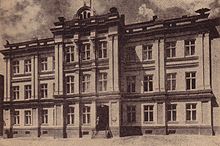Physico-economic society in Königsberg
The Physical-Economic Society was a scientific association in Mohrungen and Königsberg i. Pr. From 1792 she spread economic and scientific knowledge to improve agriculture in the province of East Prussia . Their focus changed in the 19th century. In 1945 it went under with the change of affiliation to Königsberg.
history
The idea generator and founder of the company was Andreas Köhn gen. Von Jaski the Elder. Ä. supported by the progressive landowners in his area, he had submitted a draft for the organization of the society on April 3, 1789. In the spirit of the Enlightenment , it said:
“At the general assembly all members take their seat without any priority; because there is complete equality. [...] The farmer, the citizen, the nobleman all recognize themselves as brothers in this society. "
Mohrungen and Königsberg
Friedrich Wilhelm II of Prussia confirmed the draft on February 22, 1790. In May 1791, the court of justice also agreed. On September 1st, 1792 the Royal East Prussian Mohrungen'sche Physikalisch-Ökonomische Gesellschaft was solemnly founded in Mohrungen . Köhn was elected director. The construction of a library and an art and natural history cabinet began immediately . (Internal) lectures were held and prize tasks were advertised.
Köhn v. Jaski was a member of the Royal German Society (Königsberg) , which had its seat in the Königsberg Castle . In view of the proximity of the administration and the officials, the move to the castle was therefore an obvious choice. Friedrich Leopold von Schrötter approved two rooms, including the former study of Duke Albrecht on the upper floor of the Albrechtstore. In February 1799 the books and collections were transferred. Ludwig von Baczko was responsible for furnishing the room and setting up the collection . On July 4, 1799, Köhn v. Jaski the first meeting in the Königsberg Castle. In the fourth coalition war , the work of society was suspended.
President
When Königsberg's mayor, Bernhard Gervais, became president of the society for three years in 1814, agriculture ended in favor of a general scientific and literary orientation. It in turn ended with the death of his successor Karl Gottfried Hagens in 1829. From December 1831, Karl Ernst von Baer popularized the society with public lectures . At the same time, it brought her a heyday, when Friedrich Bessel , Friedrich Burdach , and Franz Ernst Neumann established the scientific world fame of Königsberg. As v. Baer went to Saint Petersburg in 1834 , parts of the collections were given away to the trade school, the botanical garden and the zoological museum. The doctor Wilhelm Schiefferdecker restricted the public lectures again from 1858 and promoted scientific work, for example the exploration of the Samland coast by Ernst Gustav Zaddach and the geological survey of East Prussia by Gottlieb Berendt .
Long row 4
Joseph von Eichendorff lived in the house from 1824 to 1831. Here he wrote From the life of a good-for-nothing and Ezzelino da Romano . Eduard Anderson arranged for a marble plaque with Eichendorff's relief by Walter Rosenberg to be installed .
In 1878 the company bought the house, which from May 29, 1879 housed the East Prussian Provincial Museum and the library. The growing amber collection was in the castle until 1866, then in the student prison of the Collegium Albertinum (Königsberg) and finally in the Lange Reihe. Part of the collection later went to the Prussia Antiquities Society and was returned to the castle in the 1920s.
From 1906 to 1945 the house also housed the geological and paleontological institute of the Albertus University .
Publications
The lectures given at the meetings of the society also appeared in printed form, in 1834 also as “lectures from the field of natural sciences and economics” in a separate publication, until 1843 in the “Preussische Provinzialbl Blätter”, 1844 and later as “Königsberger Naturwissenschaftliche Unterhaltungen” “, Restricted by state censorship. Beginning in 1860, the "Writings of the Royal Physical-Economic Society in Königsberg" appeared annually, from 1875 to 1922 under the title "Writings of the Physical-Economic Society in Königsberg". An outline of the history of the society is available at the beginning of the first year 1860. In the year 1866 it says about the publications: “From the writings of the physical-economic society to Königsberg, in which works from the whole area of the natural history, preferably those which relate to referring to the natural history of the province of Prussia, a volume of 15 to 20 sheets appears annually with the corresponding illustrations in 2 issues. ”The lists of members preceding the volumes are informative.
In addition to geographical and geognostic works, the "writings" also contained botanical treatises, for which Professor Dr. Robert Caspary from Königsberg drew. As early as the second year of the publications, reports appeared on the meetings of the “Friends of the Flora of Prussia” under Caspary's supervision. After the “Friends of Flora” became the “Prussian Botanical Association” under Caspary's leadership on June 11, 1862, the reports of the annual meetings appeared for the first time in 1863, and soon also appeared regularly in the writings. Adolph Samter published economic articles .
literature
- Wulf D. Wagner , Heinrich Lange: The Königsberg castle. A building and cultural history . Schnell & Steiner, Regensburg 2011, pp. 126–128, ISBN 978-3-7954-1953-0 .
Individual evidence
- ↑ Circular letter from Albertus University, Christmas 1957, p. 11
- ↑ a b Writings of the Royal Physical-Economic Society of Königsberg. First year 1860 . biodiversitylibrary.org. Retrieved September 21, 2019.
- ↑ Writings of the Royal Physical-Economic Society in Königsberg. Years 4 to 15 . biodiversitylibrary.org. Retrieved September 21, 2019.
- ↑ Writings of the Physikalisch-Ökonomische Gesellschaft zu Königsberg. Year 29 to 63 . biodiversitylibrary.org. Retrieved September 21, 2019.
- ↑ Writings of the Royal Physical-Economic Society in Königsberg. Years 4 to 6 . biodiversitylibrary.org. Retrieved September 21, 2019.
